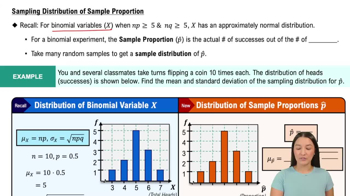A previous study found that of people preferred drinking Pepsi over Coca Cola. Use a normal distribution to approximate the probability that, from this same random sample of people, that between and people prefer Coca Cola.
Table of contents
- 1. Intro to Stats and Collecting Data1h 14m
- 2. Describing Data with Tables and Graphs1h 55m
- 3. Describing Data Numerically2h 5m
- 4. Probability2h 16m
- 5. Binomial Distribution & Discrete Random Variables3h 6m
- 6. Normal Distribution and Continuous Random Variables2h 11m
- 7. Sampling Distributions & Confidence Intervals: Mean3h 23m
- Sampling Distribution of the Sample Mean and Central Limit Theorem19m
- Distribution of Sample Mean - Excel23m
- Introduction to Confidence Intervals15m
- Confidence Intervals for Population Mean1h 18m
- Determining the Minimum Sample Size Required12m
- Finding Probabilities and T Critical Values - Excel28m
- Confidence Intervals for Population Means - Excel25m
- 8. Sampling Distributions & Confidence Intervals: Proportion1h 12m
- 9. Hypothesis Testing for One Sample3h 29m
- 10. Hypothesis Testing for Two Samples4h 50m
- Two Proportions1h 13m
- Two Proportions Hypothesis Test - Excel28m
- Two Means - Unknown, Unequal Variance1h 3m
- Two Means - Unknown Variances Hypothesis Test - Excel12m
- Two Means - Unknown, Equal Variance15m
- Two Means - Unknown, Equal Variances Hypothesis Test - Excel9m
- Two Means - Known Variance12m
- Two Means - Sigma Known Hypothesis Test - Excel21m
- Two Means - Matched Pairs (Dependent Samples)42m
- Matched Pairs Hypothesis Test - Excel12m
- 11. Correlation1h 6m
- 12. Regression1h 50m
- 13. Chi-Square Tests & Goodness of Fit1h 57m
- 14. ANOVA1h 57m
8. Sampling Distributions & Confidence Intervals: Proportion
Sampling Distribution of Sample Proportion
Problem 6.3.7a
Textbook Question
In Exercises 7–10, use the same population of {4, 5, 9} that was used in Examples 2 and 5. As in Examples 2 and 5, assume that samples of size n = 2 are randomly selected with replacement.
Sampling Distribution of the Sample Variance
a. Find the value of the population variance σ2.
 Verified step by step guidance
Verified step by step guidance1
Step 1: Recall the formula for population variance (σ²), which is given by:
Step 2: Calculate the population mean (μ) using the formula:
Step 3: Subtract the population mean (μ) from each data point in the population to find the deviations: (x - μ). Then, square each deviation to get (x - μ)².
Step 4: Sum all the squared deviations obtained in Step 3. This gives the numerator of the variance formula: .
Step 5: Divide the sum of squared deviations by the population size (N = 3) to calculate the population variance (σ²).
 Verified video answer for a similar problem:
Verified video answer for a similar problem:This video solution was recommended by our tutors as helpful for the problem above
Video duration:
2mPlay a video:
Was this helpful?
Key Concepts
Here are the essential concepts you must grasp in order to answer the question correctly.
Population Variance
Population variance is a measure of how much the values in a population differ from the population mean. It is calculated by taking the average of the squared differences between each data point and the mean. For the population {4, 5, 9}, the variance quantifies the spread of these values, providing insight into the variability within the entire population.
Recommended video:

Population Standard Deviation Known
Sampling Distribution
The sampling distribution of a statistic, such as the sample variance, describes the distribution of that statistic across all possible samples of a given size from a population. When samples are taken with replacement, each sample can yield different values, and the sampling distribution helps to understand the variability and expected behavior of the sample variance as more samples are drawn.
Recommended video:

Sampling Distribution of Sample Proportion
Random Sampling with Replacement
Random sampling with replacement means that each time a sample is drawn from the population, the selected element is returned to the population before the next draw. This method ensures that each element has an equal chance of being selected in every draw, which is crucial for maintaining the independence of samples and for accurately estimating population parameters like variance.
Recommended video:

Sampling Distribution of Sample Proportion

 6:23m
6:23mWatch next
Master Using the Normal Distribution to Approximate Binomial Probabilities with a bite sized video explanation from Patrick
Start learningRelated Videos
Related Practice
Multiple Choice
